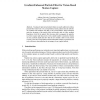Free Online Productivity Tools
i2Speak
i2Symbol
i2OCR
iTex2Img
iWeb2Print
iWeb2Shot
i2Type
iPdf2Split
iPdf2Merge
i2Bopomofo
i2Arabic
i2Style
i2Image
i2PDF
iLatex2Rtf
Sci2ools
HUMO
2007
Springer
2007
Springer
Gradient-Enhanced Particle Filter for Vision-Based Motion Capture
Tracking of rigid and articulated objects is usually addressed within a particle filter framework or by correspondence based gradient descent methods. We combine both methods, such that (a) the correspondence based estimation gains the advantage of the particle filter and becomes able to follow multiple hypotheses while (b) the particle filter becomes able to propagate the particles in a better manner and thus gets by with a smaller number of particles. Results on noisy synthetic depth data show that the new method is able to track motion correctly where the correspondence based method fails. Further experiments with real-world stereo data underline the advantages of our coupled method.
Computer Animation | Correspondence Based Estimation | HUMO 2007 | Particle filter | Particle filter Framework |
| Added | 19 Oct 2010 |
| Updated | 19 Oct 2010 |
| Type | Conference |
| Year | 2007 |
| Where | HUMO |
| Authors | Daniel Grest, Volker Krüger |
Comments (0)

